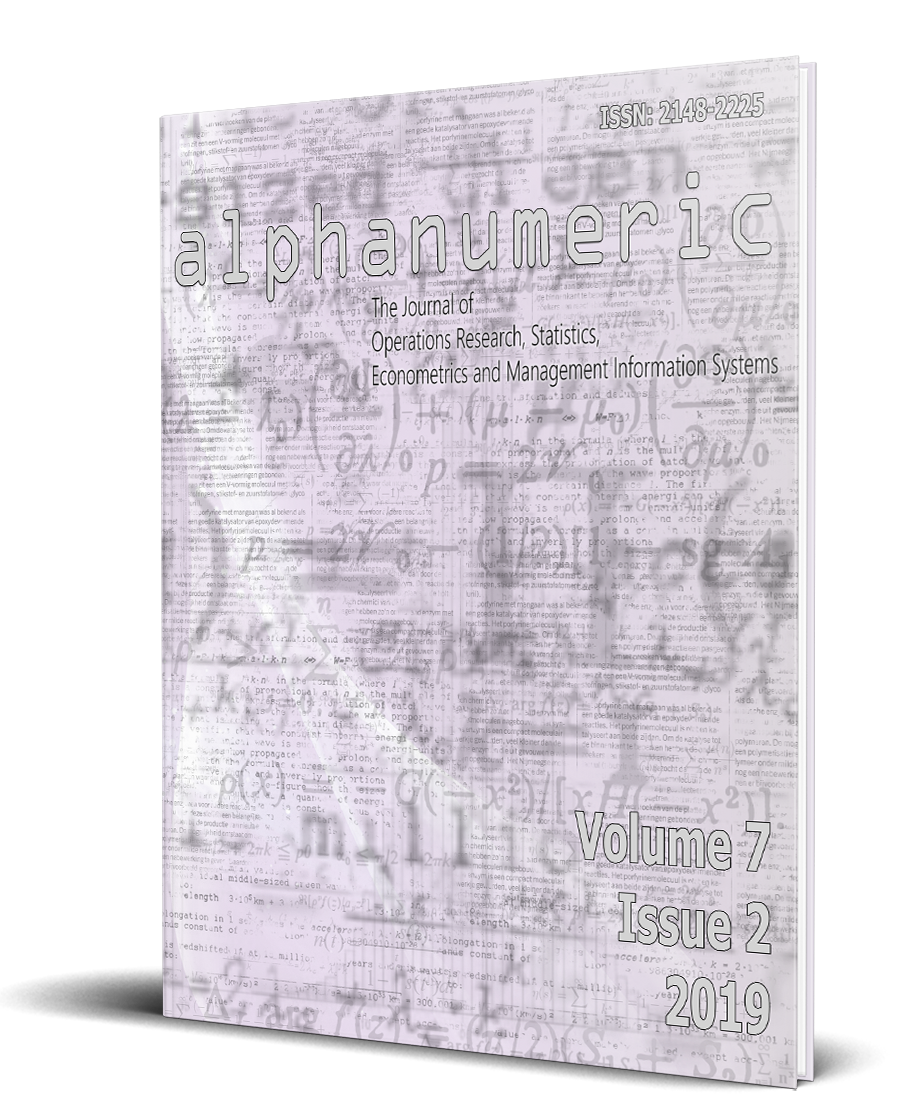
alphanumeric journal
The Journal of Operations Research, Statistics, Econometrics and Management Information Systems
Forecasting of University Students' Turkish Language Course Exam Results According to Their Exam Preparation Levels
Abstract
There are many algorithms and software in the field of forecasting. These methods are also used in education. There are studies on forecasting of student achievement in education. Forecasting of academic achievement of university students is important in terms of seeing possible situations. In this study, the achievement of the students towards Turkish Language course was forecasting with data mining methods. 160 student data, in a state university, were included in the study. For the data obtained, prediction models developed by DecisionStump, RandomTree, RandomForest, REPTree and M5P methods were created and compared with each other. 10-fold cross-validation method was used in the separation of data for training and test. In models, it will affect the student's passing grade; program, type of OSS entrance, OSS entrance score, OSS entrance rankings, the previous semester grade point average, midterm exam grade, studying status, the current study and how many points are expected from the exam, how the exam passed and final exam score was taken into consideration. Among the models, it was seen that the model established with best results with 10.16 mean absolute error and 0.72 correlation coefficient. As a result of the study, it is thought that students can take precautions by predicting the passing grade.
Keywords: Data Mining, Forecasting, Turkish Language, University Students
Jel Classification: C63
Üniversite Öğrencilerinin Türk Dili Dersi Sınav Sonuçlarının Sınava Hazırlık Düzeylerine Göre Tahminlenmesi
Öz
Günümüzde tahminleme alanında çok sayıda algoritma ve yazılım bulunmaktadır. Buna imkân tanıyan yöntemler eğitim alanında da kullanılmaktadır. Eğitimde öğrenci başarısı üzerine çalışmalar yer almaktadır. Üniversite öğrencilerinin akademik başarılarının tahminlenmesi olası durumların görülebilmesi açısından önem arz etmektedir. Bu çalışmada öğrencilerin Türk Dili dersine yönelik başarıları veri madenciliği yöntemleriyle tahmin edilmiştir. Çalışmaya Türkiye’deki bir devlet üniversitesinde Türk Dili dersini alan 160 öğrenci verisi dahil edilmiştir. Elde edilen veriler için DecisionStump, RandomTree, RandomForest, REPTree ve M5P yöntemleri ile geliştirilen tahmin modelleri oluşturulmuş ve birbirleriyle karşılaştırılmıştır. Verilerin eğitim ve test olarak ayrıştırılmasında 10-katlı çapraz doğrulama yöntemi kullanılmıştır. Modellerde öğrencinin ders geçme notunu etkileyecek program, ÖSS giriş türü, ÖSS giriş puanı, ÖSS giriş sıralaması, bir önceki dönemin not ortalaması, vize notu, çalışma durumu, mevcut çalışma ile sınavdan kaç puan beklendiği, sınav nasıl geçti ve final sınav puanı dikkate alınmıştır. Sonuç olarak en iyi ortalama mutlak hata 10.16 ve korelasyon katsayısı 0.72 ile tahminler üretildiği görülmüştür. Çalışma sonucunda öğrencilerin ders geçme notunu önceden tahmin ederek önlemler alınabileceği düşünülmektedir.
Anahtar Kelimeler: Tahminleme, Türk Dili, Veri Madenciliği, Üniversite Öğrencileri
Suggested citation
(). Üniversite Öğrencilerinin Türk Dili Dersi Sınav Sonuçlarının Sınava Hazırlık Düzeylerine Göre Tahminlenmesi. Alphanumeric Journal, 7(2), 351-356. http://dx.doi.org/10.17093/alphanumeric.583502
References
- Aksu, G. (2018). PISA Başarısını Tahmin Etmede Kullanılan Veri Madenciliği Yöntemlerinin İncelenmesi. Hacettepe Üniversitesi, Eğitim Bilimleri Ana Bilim Dalı, Doktora Tezi.
- Aydemir, E. (2018). Weka ile Yapay Zeka. Seçkin Yayınevi, Ankara.
- Aydemir, E. (2019). Ders Geçme Notlarının Veri Madenciliği Yöntemleriyle Tahmin Edilmesi. Avrupa Bilim ve Teknoloji Dergisi, (15), 70-76.
- Bramer, M. (2013). Principles of Data Mining (2nd ed.). London: Springer-Verlag.
- del Campo-Ávila, J., Muñoz, R. C., Ruiz, F. A. T., & Bueno, R. M. (2015). Mining web-based educational systems to predict student learning achievements. International Journal of Artificial Intelligence and Interactive Multimedia, 3(2), 49-54.
- Fayyad, U., Piatetsky-Shapiro, G., Smyth, P. (1996). The KDD process of extracting useful knowledge from volumes of data. Commun. ACM, 39 (11), 27–34.
- Gök, M. (2017). Makine Öğrenmesi Yöntemleri İle Akademik Başarının Tahmin Edilmesi. Gazi Üniversitesi Fen Bilimleri Dergisi, 5(3): 139-148.
- Kuyucu, Y. E. (2012). Lojistik regresyon analizi (LRA), yapay sinir ağları (YSA) ve sınıflandırma ve regresyon ağaçları (C&RT) yöntemlerinin karşılaştırılması ve tıp alanında bir uygulama. Yüksek Lisans Tezi. Gaziosmanpaşa Üniversitesi Sağlık Bilimleri Enstitüsü, Tokat.
- Martinez Abad, F., & Chaparro Caso López, A. A. (2017). Data-mining techniques in detecting factors linked to academic achievement. School Effectiveness and School Improvement, 28(1), 39-55.
- Neelamegam, S., Ramaraj, E. (2013) Classification algorithm in Data mining: An Overview, International Journal of P2P Network Trends and Technology (IJPTT), 4 (8), 369-374.
- Sieber, J. E. (2008). Data mining: knowledge discovery for human research ethics, J Empir Res Hum Res Ethics, 3 (3), 1-2.
- Thuarisingham, B. M., (2003). Web Data Mining and Applications in Business Intelligence and Counter Terrorism, USA: CRC Press LLC, Boca Raton, FL.
- Tsiakmaki, M., Kostopoulos, G., Koutsonikos, G., Pierrakeas, C., Kotsiantis, S., & Ragos, O. (2018, July). Predicting University Students' Grades Based on Previous Academic Achievements. In 2018 9th International Conference on Information, Intelligence, Systems and Applications (IISA) (pp. 1-6). IEEE.
- Weiss, S. M., Kulikowski, C. A. (1991). Computer Systems that Learn: Classification and Prediction Methods from Statistics, Neural Nets, Machine Learning, and Expert Systems. San Mateo, CA: Morgan Kaufmann.
- Witten, I. H., Frank, E., Hall, M. (2016) Data minig: Practical machine learning tools and techniques, United States of America: Morgan Kaufmann publications.
2019.07.02.MIS.03
alphanumeric journal
Pages 351-356
Received: June 27, 2019
Accepted: Oct. 27, 2019
Published: Dec. 31, 2019
2019 Aydemir, E., Kaysi, F., Gülseçen, S.
This is an Open Access article, licensed under Creative Commons Attribution-NonCommercial 4.0 International License.

scan QR code to access this article from your mobile device
Contact Us
Faculty of Transportation and Logistics, Istanbul University
Beyazit
Campus 34452 Fatih/Istanbul/Türkiye
Bahadır Fatih Yıldırım, Ph.D.
editor@alphanumericjournal.com
+ 90
(212) 440 00 00 - 13219
alphanumeric journal
alphanumeric journal has been publishing as "International Peer-Reviewed Journal" every six months since 2013. alphanumeric serves as a vehicle for researchers and practitioners in the field of quantitative methods, and is enabling a process of sharing in all fields related to the operations research, statistics, econometrics and management informations systems in order to enhance the quality on a globe scale.

